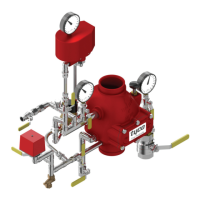TFP1090
Page 12 of 26
Air Pressure
Inspection Procedure
The Air Pressure Gauge is to be
inspected periodically based on
the requirements of the author-
ity having jurisdiction to ensure that
normal system air pressure is being
maintained.
Automatic Drain Valve
Inspection Procedure
The Automatic Drain Valve should be
inspected periodically based on the
requirements of the authority having
jurisdiction by depressing the plunger
and checking to ensure that the Auto-
matic Drain Valve is not discharging
water and/or air. A discharge of water
and/or air is an indication that the air
and/or water seats are leaking, which
could subsequently cause a false oper-
ation should the intermediate chamber
become inadvertently pressurized.
If leakage is present, take the Model
DPV-1 Valve out of service (that is,
close the Main Control Valve, open
the Main Drain Valve, close the Air
Supply Control Valve, remove the Dry
Pipe Valve Accelerator from service, as
applicable, by closing the Accelerator
Control Valve, and open the Inspector’s
Test Connection to relieve the system
air pressure to 0 psig as indicated on
the System Air Pressure Gauge), and
then after removing the Handhole
Cover, perform the following steps:
Step 1. Make sure that the Seat Ring
is clean and free of any nicks or signifi-
cant scratches.
Step 2. Remove the Clapper Assem-
bly from the valve by first pulling out
the Hinge Pin.
Step 3. Disassemble the Clapper Fac-
ing Retainer from the Clapper so that
the Clapper Facing can be removed
and inspected. Make sure that the
Clapper Facing does not show signs
of compression set, damage, etc.
Replace the Clapper Facing if there is
any signs of wear.
Step 4. Clean the Clapper Facing,
Clapper, and Clapper Facing Retainer,
and then reassemble the Clapper
Assembly.
Step 5. Reinstall the Clapper Assem-
bly with its Hinge Pin.
Step 6. Install Handhole Cover:
a. Align Handhole Cover Gasket and
Handhole Cover in proper orien-
tation with valve body (Ref. Figure
1) and hold in place
b. Apply LOCTITE No. 242 (or equiv-
alent) to Hex Bolt threads
c. Insert Hex Bolts through Hand-
hole Cover Gasket and Handhole
Cover, hand-tighten into valve
body
d. Using crossdraw sequence to
assure uniformity, wrench-tighten
Hex Bolts to appropriate torque
values (Ref. Table D)
e. Inspect to assure all Hex Bolts
are securely tightened
Accelerator
Inspection Procedure
It is recommended that the Accelera-
tor be inspected periodically based
on the requirements of the authority
having jurisdiction to determine proper
operation of the Accelerator without
having to trip the Dry Pipe Valve. This
procedure must also be used whenever
flooding the system would expose the
water to freezing conditions.
See Technical Data Sheet TFP1112 for
guidance with regard to trouble shoot-
ing of the Model ACC-1 Dry Pipe Valve
Accelerator.
Step 1. Verify that the Reset Knob is
screwed in.
Step 2. Close the system’s Main Con-
trol Valve and open the Main Drain
Valve to relieve the supply pressure to
the Dry Pipe Valve.
Step 3. Verify that the Accelerator
Control Valve is open.
Step 4. Open the Inspector’s Test
Connection. Verify that the time to
Accelerator trip is essentially the same
as in previous tests. A momentary
burst of air from the Automatic Drain
Valve indicates that the Accelerator has
tripped.
As the system pressure is decreasing,
check for any sign of water being dis-
charged from the Accelerator Relief
Port.
Step 5. Depress the plunger of the
Automatic Drain Valve. A steady stream
of exhausting air indicates that the
Accelerator has properly latched in the
Tripped position.
Step 6. Close the Accelerator Con-
trol Valve and the Inspector’s Test
Connection.
Step 7. After the system automatically
restores itself to its normal air pressure,
reset the Accelerator and Dry Pipe
Valve in accordance with the Valve Set-
ting Procedure Steps 10 and 11.
Nominal
Valve Sizes
DN
Torque
Nm
DN65 41
DN80 41
DN100 41
DN150 75
TABLE D
HANDHOLE COVER BOLTS
MAXIMUM TORQUE

